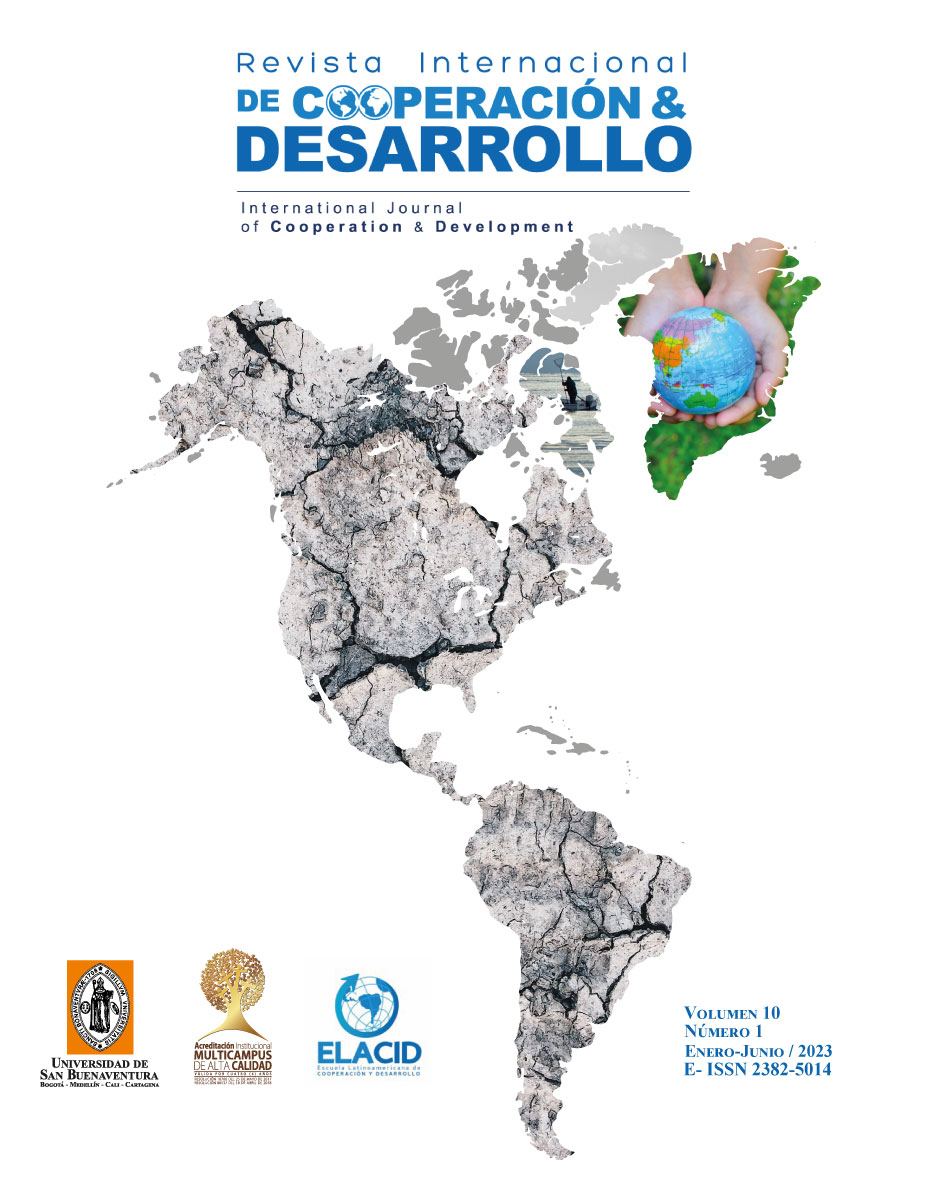INTERNATIONAL JOURNAL OF COOPERATION AND DEVELOPMENT
Assignment of Rights
Authorization for reproduction, publication, communication and distribution of a literary, artistic or scientific
Work.
I , ____________________________________________, author of the book and / or article , of legal age , resident of the city of _________________ , identified with citizenship / passport n° ______________________ issued on _______________________, in exercise of his physical and mental faculties , part henceforth be called the AUTHOR , supports the following authorization to the reproduction, publication, communication and distribution of a work, perform the following terms:
1. Regardless of current legal regulations due to the linking of the parties to this contract, and any kind of legal presumption , the parties agree that the AUTHOR authorize ( name of the publisher ) to reproduce , publish , communicate and distribute the material referred to in the International Journal of Cooperation and Development of the University of San Buenaventura.
2. Such authorization lies in particular on the copyright of the work, by any means known or unknown, publication of the work, distribution of the work , either directly or through third parties for purely educational purposes.
3. AUTHOR agrees to report and declare the existence of this authorization and to preserve the right of the International Journal of Cooperation and Development of the first publication of the work.
4. AUTHOR declares that the article is original and that it is his sole creation, no impediment of any kind exist for the authorization he is doing, besides being responsible for any action claim, plagiarism or other type of claim that might arise about .
5. Such permission is free of charge.
6. Moral copyright in the article are solely the AUTHOR and the University of San Buenaventura expressly agrees to recognize and respect them rigorously.
The Author and / or AUTHORS
SIGNATURE
Abstract
This paper provides a broad overview of the issue of rising inequality and builds an international and multidimensional taxonomy of economic inequality. We use a hierarchical cluster analysis that enables us to identify five groups of countries with distinctive economic inequality characteristics, which show that, despite national and regional specificities, both developed and developing countries face important difficulties in reducing social and economic disparities. The resulting classification may be useful to map out the various national realities of economic inequality across countries. The results suggest that there should be avoided a “one size fits all” international strategy to address the different patterns of inequality that we have identified across the World. Still, it is crucial to acknowledge the importance of the particularities of each cluster and each geographic region regarding a complex and multidimensional phenomenon that has become a global challenge for the 21st Century
Keywords:
References
Arrighi, G. 2007. Adam Smith in Beijing: lineages of the twenty-first century, Verso. London.
Atkinson, A.B. On the measurement of inequality, Journal of Economic Theory 1970;2: 244-263
Atkinson, A.B. Measuring Top Incomes: Methodological Issues. In: A. B. Atkinson and T. Piketty (eds.): Top Incomes over the Twentieth Century: A Contrast Between Continental European and English-Speaking Countries. Oxford University Press; 2007. p. 18-42.
Atkinson, A.B. Inequality. What can be done? Cambridge: Harvard University Press; 2015.
Atkinson, A. B. and Bourguignon F. (eds) Handbook of Income Distribution. Volume 2. Pages 1-2251. Amsterdam: North-Holland; 2015.
Atkinson, A.B., Piketty, T. and Saez, E. Top Incomes in the Long Run of History, Journal of Economic Literature 2011; 49:3-71.
Bourguignon, F. Spreading the Wealth, Finance and Development 2018; 55:22–24.
Brei, M; Ferri, G. and Gambacorta, F. Financial structure and income inequality, Bank for International Settlements Working Papers No 756; 2018.
Calinski, T. and Harabasz, J. A dendrite method for cluster analysis. Communications in Statistics - Theory and Methods 1974; 3:1–27.
Carsten, J. & van Kersbergen, K. Politics of Inequality, Palgrave. NY, 2017.
Chang, H-J. 23 Things they don't tell you about capitalism. London: Penguin Books; 2011.
Cobham, A., Schlögl, L., Sumner. A. Inequality and the Tails: the Palma Proposition and Ratio. Global Policy 2016;7(1):25-36.
Credit Suisse Research Institute Global Wealth Report 2012. Zürich, Switzerland: Credit Suisse AG; 2012.
Credit Suisse Research Institute. Global Wealth Report 2014. Zürich, Switzerland: Credit Suisse AG., 2015.
Domínguez Martín, R. 2014. “International Cooperation Perspectives and Sustainable Development After 2015”. Revista Internacional de Cooperación y Desarrollo 1 (2):5-32
Dos Santos, T. 2011. Imperialismo y dependencia. Biblioteca Ayacucho, Caracas
Everitt, B.S., Landau, S., Leese, M. and Stahl, D. Cluster analysis. Chichester: John Wiley and Sons; 2011.
Fields. G. Distribution and Development: A New Look at the Developing World. Cambridge, Massachusetts: The MIT Press; 2002.
Fleurbaey, M. and Klasen, S. Inequalities and social progress in the future, in World Social Science Report, 2016: Challenging inequalities; pathways to a just world. IDS and UNESCO, Paris; 2016.
Gaventa, J. Consequences and futures of inequalities (an introduction to Part II), in World Social Science Report, 2016: Challenging inequalities; pathways to a just world. IDS and UNESCO, Paris; 2016.
Gouda, T. The global concentration of wealth, Cambridge Journal of Economics 2018; 42: 95–115. doi:10.1093/cje/bex020
Ibarra, C. and Ros, J.: The decline of the labor income share in Mexico, 1990–2015, World Development 2019; 122: 570–584.
ICTD/UNU-WIDER: Government Revenue Dataset. (2020) https://www.wider.unu.edu/project/government-revenue-dataset
Josa, I. and Aguado, A. Measuring Unidimensional Inequality: Practical Framework for the Choice of an Appropriate Measure. Social Indicators Research; 2020. https://doi.org/10.1007/s11205-020-02268-0
Kakwani, N., Khandker; S. and Son, H. Pro-poor growth: concepts and measurement with country case studies”, Working Papers 1, International Policy Centre for Inclusive Growth; 2004.
Kaldor, N.: Collected economic essays 8. Reports on taxation 2: papers relating to foreign governments. Holmes and Meier, NY; 1980.
Kanbur, R.: Inequality in a global perspective, Oxford Review of Economic Policy 2019; 35(3): 431–444.
Keeley, B.: Income Inequality: The Gap between Rich and Poor, OECD Insights, Paris: OECD Publishing; 2015.
Keynes, J.M.: The General Theory Of Employment, Interest And Money, Cambridge University Press: Cambridge; 1936.
Lahoti, R., Jayadev, A. and Reddy, S.: The Global Consumption and Income Project (GCIP): An Overview, LIS Working papers 655, LIS Cross-National Data Center; 2016.
Lakner, C. and Milanovic, B.: Global Income Distribution: From the Fall of the Berlin Wall to the Great Recession, The World Bank Economic Review 2016; 30(2): 203–232.
La Porta, R. and Shleifer. A. Informality and Development, Journal of Economic Perspectives 2014; 28(3): 109-126.
Long, C. and Miller, M. Taxation and the Sustainable Development Goals. Do good things come to those who tax more?, ODI briefing paper. Overseas Development Institute; 2017.
Milanovic, B. Global Inequality Recalculated and Updated: The Effect of New PPP Estimates on Global Inequality and 2005 Estimates. The Journal of Economic Inequality 2012; 10: 1–18.
Milanovic, B. Global Inequality. A New Approach for the Age of Globalization, Harvard University Press, Cambridge; 2016.
Milligan G.W. and Cooper, M. An examination of procedures for determining the number of clusters in a data set. Psychometrika 1985; 50(2): 159–179.
Mooi, E. and Sarstedt, M.: A concise guide to market research. Berlin. Springer-Verlag; 2011.
Mueller, J.: War Has Almost Ceased to Exist: An Assessment. Political Science Quarterly 2009; 124(2): 297-321.
Mundell, R. Capital Mobility and Stabilization Policy under Fixed and Flexible Exchange Rates. The Canadian Journal of Economics and Political Science 1963;29(4): 475-485.
Nino-Zarazúa, M., Roope, L, and Tarp, F. Global inequality: relatively lower, absolutely. Review of Income and Wealth 2017;63(4): 661-684.
OECD. Illicit Financial Flows from Developing Countries: Measuring OECD Responses. Paris, OECD; 2014.
Ostry, J., Loungani, P. and Berg, A. Confronting Inequality. How Societies Can Choose Inclusive Growth. Columbia University Press, New York; 2019.
Palma, J.G. Behind the Seven Veils of Inequality. What if it’s all about the Struggle within just One Half of the Population over just One Half of the National Income?, Development and Change 2019; 50(5): 1133–1213.
Palma, J. G. Has the Income Share of the Middle and Upper-middle Been Stable around the ‘50/50 Rule’, or Has it Converged towards that Level? The ‘Palma Ratio’ Revisited. Development and Change 2014; 45(6): 1416–1448.
Piketty, T. Capital in the Twenty-first Century. The Belknap Press of Harvard University Press, Cambridge; 2014.
Ravallion, M. Inequality and Globalization: A Review Essay, Journal of Economic Literature 2018; 56(2), 620–642.
Rawls, J. A Theory of Justice. The Belknap Press of Harvard University Press, Cambridge; 1971.
Roemer, J E and Trannoy, A. Equality of opportunity, in A B Atkinson and F Bourguignon (eds), Handbook of Income Distribution vol 2A, Amsterdam: North-Holland; 2015.
Scheidel, W.: The Great Leveler. Violence and the History of Inequality from the Stone Age to theTwenty-First Century, Princeton University Press, New Jersey; 2016.
Stiglitz, J. Distribution of Income and Wealth Among Individuals, Econometrica 1969; 37(3): 382-397.
Stiglitz, J. Where modern macroeconomics went wrong, Oxford Review of Economic Policy 2018; 34(1–2): 70–106.
UNDESA. Note on Income Inequality Data. Global Dialogue for Social Development Branch Emerging Issues and Trends Section. New York; 2018.
United Nations. Transforming our world: the 2030 Agenda for Sustainable Development. Resolution adopted by the General Assembly on 25 September 2015. A/RES/70/1. New York; 2015.
UNDP. Human Development Report 2019. Beyond income, beyond averages, beyond today: Inequalities in human development in the 21st century. New York.
Wallerstein, I. 2004. World-systems analysis: an introduction. Duke University Press, Durham and London.
World Bank. World databank 2020 http://data.worldbank.org, accessed 19 August 2019
















